
The First and Only Weekly Online Fanzine Devoted to the Life and Works of Edgar Rice Burroughs |
 |

The First and Only Weekly Online Fanzine Devoted to the Life and Works of Edgar Rice Burroughs |
 |
Since the last days of the twentieth century, nothing has been heard from...
...beyond 30ºW
...until now
Making my departure from London's Gatwick Airport, I knew that within a few days, I would be taking a step back through time across a century or more and walk in the footsteps of Edgar Rice Burroughs during his days as a cadet at the Michigan Military Academy. To stroll across the parade ground where Burroughs and his fellow cadets once had to drill for hours on end, to walk the long hallways of the barracks, to stand where Burroughs groomed his horse, and to cross the nearby lake onto Apple Island where they took their recreation.The flight into Newark, NJ gives passengers a spectacular view of Manhattan across the Hudson River. The twin towers of the World Trade Centre magically draws your eyes towards them as they stretch up into the sky. Within a month they would be gone, destroyed by the most savage crime in history along with the thousands of lives it took with them and the world can never be the same again.
The drive to the home of Brian Bohnett took me through Binghamton, NY (site of the ECOF gathering a week after the M.M.A. Symposium), across Pennsylvania and Ohio, finally arriving in Holt, MI (just south of Lansing). Brian had only recently completed his latest book titled, Edgar Rice Burroughs and the History of the Michigan Military Academy, Them Was The Days! (The final line is taken from ERB's unpublished autobiography that referred to his time at the M.M.A. and is a must read for any fan of ERB) and was to be finally released at the M.M.A. Symposium. With the help of Richard 'Buzz' Brown (of the local Greater Bloomfield Historical Society), the book is littered with photographs and information, interspersed with extracts from diaries and newspapers alike, it takes the reader through an historical journey of the rise and fall of the Michigan Military Academy.
'Buzz' had been invited to give a talk the year before at the annual Dum-Dum held near Grand Rapids, MI and so enthused by his reception, he decided to host a one-day symposium on the very grounds of the former M.M.A. (now known as St. Mary's College) in Orchard Lake, MI. The date of Saturday, August 11th, 2001 was deliberately set for the Symposium to coincide within a few days of the ECOF gathering with the hope that it would attract many Burroughs fans planning on going to the convention. Unfortunately this did not work out quite well as had been hoped with only four fans attending (Bill Ross, Mike Conran, Brian Bohnett and myself). However, former college students and members of the local Historical Society bolstered our numbers to a sufficient size for the event to be a success.
Shortly after 7:00am, Brian and I loaded up my car with a selection of memorabilia that he had collected during the research for his book, so that they could be displayed at the college. Set on the north-east coast of Orchard Lake, the former Academy overlooks the now picturesque lake which at one time was not quite so peaceful as the stillness was shattered by cadets who would fire their cannons at targets set upon floats several hundred yards from the shoreline.
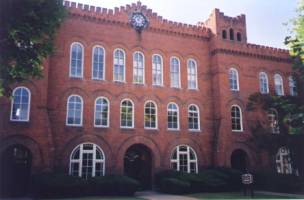
The Academy Building |
Registration for the symposium took place in the lobby of the Academy Building at 9:00am. Each attendee was given a package that included a copy of Brian's new book, Them Was The Days!; a CD that contains additional information of the M.M.A.; and a reproduction of the 1898 M.M.A. Cadet Regulation booklet. In the west wing of the Academy building that was once home to the library frequented by the young cadets, it was now lined with display boards and tables filled with memorabilia supplied by Buzz and Brian. |
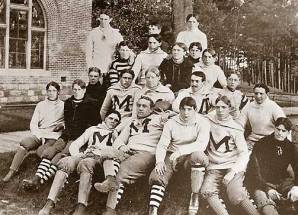
M.M.A. 1895 Football Team with ERB |
After we had seated ourselves in the East wing, Buzz Brown began the proceedings with a few opening remarks regarding the former Academy, Brian's new book, and also the help he had received from faculty members and the local historical society alike. During this commentary, Buzz mentioned that there were several large rocks to be found dotted around the campus which became a sporadic tradition for the cadets to carve that particular year into them. He continued by pointing out to us Burroughs fans that the rock where Ed and his fellow football team mates once posed for a photograph was immediately outside of the Academy building. |
After we had seated ourselves in the East wing, Buzz Brown began the proceedings with a few opening remarks regarding the former Academy, Brian's new book, and also the help he had received from faculty members and the local historical society alike. During this commentary, Buzz mentioned that there were several large rocks to be found dotted around the campus which became a sporadic tradition for the cadets to carve that particular year into them. He continued by pointing out to us Burroughs fans that the rock where Ed and his fellow football team mates once posed for a photograph was immediately outside of the Academy building.Our first panel titled, Archives, Libraries and Historical Societies was opened by Dave Poremba, a Director of the Burton Historical Collection in the Detroit Public Library. He gave us an account of the library, its collections, how members of the public could access information and their future plans for the library. The second member of the panel was Leslie Edwards from the Oakland County Pioneer and Historical Society. She began her opening remarks by stating that since they represented the private sector, they tended to guard their collections far more jealously than did the Detroit Library. Access however can be obtained and they hold a wealth of information to any interested parties. Cataloguing and archiving historical material have given their problems to the societies, but in recent years the internet has been both beneficial and detrimental alike affecting the cost of memorabilia and even donated items available to them.
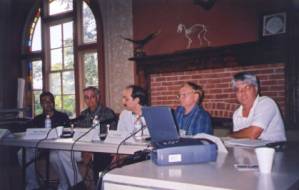
Neil Hepburn, Dave Finney, Brian Bohnett, Lee Snyder, Richard 'Buzz' Brown |
Buzz then introduced the second phase of the symposium called, History with Words and Pictures. Neil Hepburn from the Oakland County Historical Society, Dave Finney, a historian whose special interests lie with Judge Joseph Tarr Copeland (who built his home, now known as The Castle and which still stands today, and went onto become the site for the former Academy). Lee Snyder, a reporter for the Observer & Eccentric newspaper in Orchard Lake, and finally Brian Bohnett, a graphic designer by trade and part-time author. As if performing a television documentary with Buzz playing the role of the narrator and assisted by a projection of photographs, the panel each took their turn in reading from a script that contained extracts of letters, newspapers and diaries giving an indication of life as a cadet at the Michigan Military Academy. |
Before we took a recess for lunch, Buzz then invited attendees if they had any questions for the panel. Knowing something of the Academy and Brian's subsequent research and his discovery in local newspapers of the hoax 'duel' that almost took place between Burroughs and his fellow cadet Charles Campbell, I asked if the event caused consternation amongst local residents of students running around, brandishing firearms at one another. However, Buzz replied that so far they had not discovered any newspaper reports regarding such concerns but it would be something they would look out for.
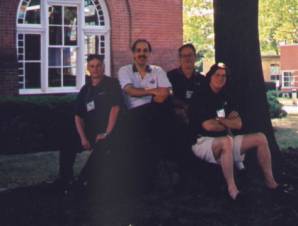
Laurence Dunn, Brian Bohnett, Mike Conran, Bill Ross |
After several more questions, we then took our break for lunch. Rather than head directly towards the dining hall, instead I went outside to take a closer look at the rock Buzz had mentioned earlier in the morning. Under a tree beside the Academy Building, carved deep with the numbers 1884 stood the rock just as it had for the past 117 years. Bill Ross and Mike Conran then emerged from the building and headed in my direction closely followed by Brian. It was not an occasion to be missed and the four of us took our positions about the rock just as Ed and his friends had done many years before. With the assistance of fellow attendee, Paul Basak (from Virginia and a former graduate of St. Mary's College) we posed for our picture. |
Our lunch at the St Mary's College Dining Hall included soup, salad, two hot main courses to choose from, plus a selection of dessert dishes. During this break and socialising with other attendees, I was approached by local reporter Lee Finney who had just heard mention that I had travelled all the way from England for this event. Besides Lee's participation in the panel, he was there to record the event for an article in his newspaper that would appear the following week.On our return to the Academy Building, our final session was titled, Stories That Didn't Make The Book which began with a 15-minute video presentation created by Brian which featured the seven cadets that graduated from the MMA in 1881. With the help of letters, historical documents, school and newspaper reports read out by several of his friends, supported by suitable music and images of the time, Brian acts as a narrator and takes us on a journey through the days these youngsters spent as cadets and how their lives later panned out following their departure from the Academy.
After the video ended, the group then took a short walk to the shoreline of Orchard Lake where we boarded a pontoon to take us to Apple Island that lies at the centre of the lake. Unfortunately it immediately became apparent that our numbers were causing the boat to stick in the shallow waters, and even after we all had moved to the opposite end of the boat in an attempt to shift the weight, we remained firmly stuck in the mud. Our saviour came in the form of Bill Ross who jumped into the water and managed to push us clear of the sandy bottom.
As we approached the island, we spotted a lake patrol officer preventing several students from landing on the island. Our guides, who are more accustomed to taking young school children around the island, began by giving us a brief history of the island and some of the local legends particularly those relating to Chief Pontiac. Pontiac was a powerful Ottawa chief who set into motion the most formidable Native American resistance that the English and colonials had ever faced when he issued a call to the Indian tribes in Michigan to assert their independence of the British. Several forts fell to their attacks and only the long drawn out siege at Detroit and several tribes dropping out of the war, preferring to trade rather than fight any further, brought an end to the campaign. In 1769, Pontiac at the age of 49 was murdered by a Kaskaskia indian in Cahokia, IL. However, one of the local legends we heard might have us believe that his body was de-skinned and brought to Apple Island where his remains were laid to rest.
Separating the tall tales generally aimed at the children and factual information was not difficult but fun to listen to all the same. The island was at one time a reservation for the native Americans until it was sold off in 1827. Several changes of ownership followed and the land was cleared to become a summer retreat for the Campbell family. In 1915 it was sold off once again and finally donated to the West Bloomfield School District as a nature sanctuary in 1970.
On our return from the island, we took the opportunity to wander freely around the college grounds. Many of the original buildings from the days of the Michigan Military Academy still stand today although most have gone through some remodelling. The barracks where Ed was quartered during his time as a cadet and later as an instructor has had two new wings added and according to Ed's notes (now in the hands of George McWhorter at the University of Louisville), he was stationed in Room 48 on the 3rd floor. Unfortunately with the addition of the two wings, room numbers have changed making it difficult to determine which was his room. However, Mike and Bill noticed from old photographs shown in Brian's book, that the building now appeared to be closer to the parade ground. Indeed, when they looked closer, a corner stone could be found approximately one third back from the face of the building indicating that it had been extended on the front. In light of this, we now know that the corridor that runs through the centre of the building, once ran along the front face of the barracks and that Room 48 is somewhere along the rear face of the third floor.
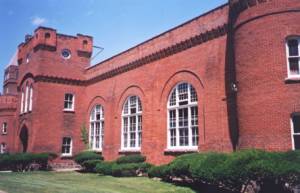 |
Outside the barracks, the once barren parade ground now has lush green lawns, lined with trees and bushes. Directly opposite sits the gymnasium with its prominent square tower in the centre and has two circular turrets at either end of the building. Inside, the viewing gallery still remains apart from one small section that has been removed. Apart from that, its usage remains unchanged to this day. As we walked around the side of the gymnasium, we could see the top of a bricked up arched doorway that was now almost completely submerged. This was once the entrance to the stables that lay beneath the gymnasium where the cadets would tend their horses. |
North of the barracks stands the Castle that was once the home of Joseph Tarr Copeland and later became a major part of the Oakland Lake Hotel that stood on the site. By the time of the Academy, this then became the residence of the Commandant. To one side of the front entrance is a circular turret that at one time towered above the main structure. However, decay set in and the top portion of the turret had to be removed for safety reasons. With so many of the original buildings remaining, it is not difficult to imagine seeing the young cadets on the verge of manhood, going about their duties, learning the basics that will lend themselves well in their later life. With the Symposium over, the remaining attendees were then invited for an evening meal in nearby Pontiac. As Bill had an early flight home the next day from Grand Rapids, he and Mike left early as they had a three hour drive ahead of them. Brian and I stayed just a little longer, deciding against rooming in the barracks overnight as was our original plan. It had been a long and rewarding day walking in the footsteps of Edgar Rice Burroughs as we too turned away and headed for home.
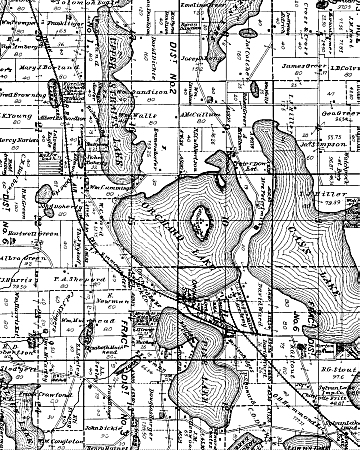
Click on the map to go to the more-detailed, large scale version. For further information of the Michigan Military Academy and Burroughs life stationed as a cadet there, should obtain Brian Bohnett’s book: Edgar Rice Burroughs and the History of the Michigan Military Academy, Them Was The Days! Available direct from Brian at: 1909 Chestnut Street, Holt, Michigan 48842. Tel. (517) 699-8432 (evenings only) or email him at: LordGreystoke@attglobal.net Cost $20.00 plus $3.00 shipping.
|
![]()
![]()
![]()
Volume
0603

BILL
HILLMAN
Visit
our thousands of other sites at:
BILL
& SUE-ON HILLMAN ECLECTIC STUDIO
ERB
Text, ERB Images and Tarzan® are ©Edgar Rice Burroughs, Inc.-
All Rights Reserved.
All
Original Work ©1996-2004/2010 by Bill Hillman and/or Contributing
Authors/Owners
No
part of this web site may be reproduced without permission from the respective
owners.